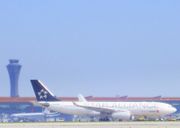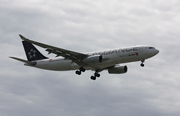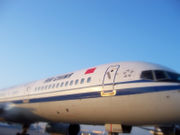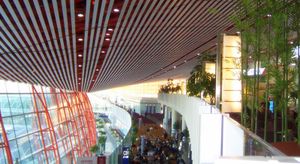Air China
 |
||||
|
||||
| Founded | 1988 | |||
|---|---|---|---|---|
| Hubs |
|
|||
| Focus cities |
|
|||
| Frequent-flyer program |
|
|||
| Member lounge | VIP Lounge | |||
| Alliance | Star Alliance(2007) | |||
| Fleet size | 257 (+232 orders)[1] | |||
| Destinations | 185 | |||
| Parent company | China National Aviation Holding Company | |||
| Headquarters | Beijing Tianzhu Airport Industrial Zone Shunyi District, Beijing, People's Republic of China |
|||
| Key people | Kong Dong, Chairman Cai Jianjiang, President |
|||
| Website | www.airchina.com | |||

Air China (SEHK: 0753, LSE: AIRC, SSE: 601111) (simplified Chinese: 中国国际航空公司; traditional Chinese: 中國國際航空公司, Pinyin: Zhōngguó Guójì Hángkōng Gōngsī, literally meaning "China International Airlines Company", abbreviated 国航) is the People's Republic of China's state-owned and second-largest commercial airline after China Southern Airlines. Its logo consists of a phoenix in the form of the acronym VIP, and "Air China" in both English and Chinese, which was autographed by Deng Xiaoping. It operates 5,090 flights each week worldwide and is the 18th largest airline in the world by fleet size. Air China is also the world's largest carrier by market capitalisation.[2] It has its headquarters in the Beijing Tianzhu Airport Industrial Zone in Shunyi District, Beijing.[3][4]
Air China's main hubs are Beijing Capital International Airport, Chengdu Shuangliu International Airport and Shanghai Pudong International Airport, with other focus cities at Hangzhou Xiaoshan International Airport, Chongqing Jiangbei International Airport, Tianjin Binhai International Airport and Hohhot Baita International Airport.[5] Air China currently flies to approximately 120 destinations; the most destinations from its own Beijing hub.
The airline flew 41.28 million passengers in 2009, with a passenger load factor of 76.53%. Results improved with an increase of 14.23% from 36.14 million in 2008. Its turnover was recorded to be 51.39 RMB, which was a decrease of 2.86% from 2008.[6]
It is the 5th largest airline in Asia, 5th largest in the world in terms of domestic cargo traffic and 18th largest airline in the world in terms of fleet size.
Contents |
History
Beginning
Air China was established on July 1, 1988. Its formation was a result of the government's decision to split the operating divisions of Civil Aviation Administration of China (CAAC) into separate airlines.[7] The CAAC was restructured in late 1987 and divided into six airlines, namely Air China, China Eastern, China Southern, China Northern, China Southwest, and China Northwest. Air China, based in Beijing, was given chief responsibility for intercontinental flights, and took over the CAAC's long haul aircraft (Boeing 747s, 767s, and 707s, as well as medium-haul 737s) and routes when it was granted its autonomy on July 1, 1988.
At the time of its launch 1988, Air China had 6,000 employees and served 31 international and 30 domestic destinations. It was China's largest airline company and the national flag carrier. In 1989, Air China posted a net profit of $106 million on revenues of $383 million. In that same year, Air China entered a joint venture with Lufthansa, which provided 40 percent of the capital, or $220 million, to create the Beijing Aircraft Maintenance Center (Ameco Beijing). It specialized in the upkeep of the Boeing aircraft that comprised Air China's fleet.[8] The venture was expanded with another $218 million (CN¥1.2 billion) in 1992. Ameco Beijing employed nearly 4,000 people, a little fewer than 50 of them from Lufthansa.[9] Air Transport World reported the company preferred to source its needs through joint ventures due to the country's lack of hard currency.[10] Its Beijing Air Catering was 40 percent owned by a large Hong Kong caterer.[11]
Consolidation
In mid-2000, the CAAC repeated earlier calls for a consolidation of the ten airlines it controlled into three.[12] (Air China, China Southern, and China Eastern were to each acquire the smaller airlines.) However, the CAAC blocked a proposed merger in September 2000 between Air China and China Southern on anti-competitive grounds.[13]
In January 2001, the CAAC's ten airlines announced they had agreed on a merger plan.[14] Air China was to acquire China Southwest Airlines; before the acquisition, Air China was the country's fourth strongest domestic airline. This was to create a group with assets of ¥n56 billion (HK$ 52.5 billion), including 118 aircraft.[15] On October 28, 2002, Air China consolidated with China National Aviation Corporation and China Southwest Airlines.
During 2004, Air China absorbed Zhejiang Airlines (a subsidiary of CNAC). On December 15, 2004 the company listed its shares on the Hong Kong and London Stock Exchanges. Air China has shareholdings in Air China Cargo (51%), Air Macau (51%, soon to be 80.9%[16]) and also holds majority shares of Shandong Airlines. On August 17, 2009, a joint announcement revealed a new shareholding structure in which Air China acquire a 29.99% stake in Cathay Pacific, while the latter will own 18.09% of the former.
Operations
Air China operates in four segments:[17]
- Airline Operations segment, which comprises the provision of air passenger and air cargo services;
- Engineering Services segment, providing aircraft engineering services, such as aircraft maintenance, repair and overhaul services;
- Airport Terminal Services segment, offering ground services that include check-in services, boarding services, premium class lounge services, ramp services, luggage handling services, loading and unloading services, cabin cleaning and transit services,
- Others segment, which comprises the provision of air catering services and other airline-related services.
Subsidiaries
- Air China Cargo, flight logistics company
- Air China Business Jet, business jet company
Financial performance
For fiscal year ending December, 2006:
- Sales: $5,747.4M
- One year growth: 21.1%
- Net income: $422.7M
- Income growth: 38.1%
Destinations

Air China's route network extends throughout Asia to the Middle East, Western Europe, and North America. The majority of the routes operate from its Beijing hub.
It currently operates a significant number of Asian, Australian and European destinations from Shanghai Pudong International Airport. It also has some international routes operating and connecting from Chengdu Shuangliu International Airport, Chongqing Jiangbei International Airport, Dalian Zhoushuizi International Airport, Dubai International Airport, Hangzhou Xiaoshan International Airport, Kunming Wujiaba International Airport, Madrid Barajas Airport, Nanning Wuxu International Airport and Xiamen Gaoqi International Airport.
Air China is upgrading these routes to larger aircraft from 2008/2009, Beijing-Delhi to A340 from 767-300ER, Beijing-Dubai to A330-200 from 767-200ER, Beijing-Chengdu-Karachi to 757 from A319 with new routing replacing Urumqi stopover and Beijing-Stockholm to A330-200 from 767-200ER.
On December 10, 2006, it made its first flight to São Paulo (via Madrid), which became its first South American destination. This was the airline's longest direct flight. The service began with the Boeing 767-300 aircraft but because of its popularity, the service has been upgraded to A330-200. Air China suspended service to São Paulo in September 2008. The airline resumed services to São Paulo on December 20, 2009.
Routes to Australia, Frankfurt, Madrid currently operated by Airbus A330-200s may be replaced by Boeing 787 Dreamliners. The Boeing 787 Dreamliners will be used on flights to Toronto and Washington, D.C. once launched.
Air China is launching many flights to European destinations, as it believes these services will become very popular in the coming years. The airline has already stated they are happy to make losses on these routes at first, hoping that Air China will increase its penetration into this market and become a premier choice for passengers flying from Europe to China.
Air China announced that it will launch Shanghai (Pudong)-Chengdu-Bangalore service on February 27, 2010 on an A319.[18]
Air China will launch Beijing-Manila-Beijing service on March 30, 2010.
Air China announced that it would double Vancouver-Beijing frequencies by late 2010 or early 2011. From June 2010, frequencies would rise from 7 to 10, and eventually be raised to 14 by late 2010 or early 2011. [19]
Air China also announced that they are considering a direct flight from Chengdu to Ho Chi Minh City.[20]
Cargo and passenger service expansion plans
Air China is looking at the United States for international cargo and passenger service expansion. A June 17, 2008 St. Louis Beacon reported that Air China planned to establish a cargo hub at Lambert St. Louis International Airport.[21][22] The United States Department of Commerce allowed expansion of the foreign trade zone near Lambert airport on February 13, 2009.[23]
Fleet
_737-800_Exteriors.jpg)
Passenger
As of July 2010, the Air China fleet includes the following aircraft:
| Aircraft | Total[24][25] | Orders | Passengers (First/Business/Economy)[26][27] |
Notes |
|---|---|---|---|---|
| Airbus A319-100 | 33 | 0 | 128(8/120) | |
| Airbus A320-200 | 13 | 16 | 158(8/150) | |
| Airbus A321-200 | 24 | 32 | 185(12/173) | |
| Airbus A330-200 | 20 | 0 | 251(36/215) 283(12/271) |
|
| Airbus A330-300 | 3 | 17 | 279(20/259) | Replace Airbus A340-300 from 2010-2011 |
| Airbus A340-300 | 6 | 0 | 255(8/28/219) | To be phased out from 2010-2011 |
| Boeing 737-300 | 29 | 0 | 128(8/120) | |
| Boeing 737-700 | 20 | 0 | 128(8/120) | |
| Boeing 737-800 | 73 | 137 | 167(8/159) | |
| Boeing 747-400 | 3 | 0 | 344(10/42/292) | |
| Boeing 747-400M(combi) | 5 | 0 | 280(10/24/246) | |
| Boeing 757-200 | 13 | 0 | 200(8/192) | |
| Boeing 767-300 | 4 | 0 | 225(10/26/189) | To be phased out from 2011 |
| Boeing 767-300ER | 1 | 0 | 230(30/200) | To be phased out from 2011 |
| Boeing 777-200 | 10 | 0 | 314(12/49/253) 345(49/296) |
|
| Boeing 777-300ER | 0 | 15 | TBA | |
| Boeing 787-9 | 0 | 15 | TBA | Deliveries from late 2015 (order was switched from -8 to -9 August 2010) |
| Total | 257 | 232 |
As of January 2010, Air China's average fleet age was 13.5 years old.[28]
Air China has two other business jets: one Gulfstream IV and one Bombardier Learjet 45.
Aircraft orders
Air China has signed agreements with:
- Boeing, on August 8, 2005, for the purchase of 15 Boeing 787 aircraft for delivery from mid-2008 to end 2010. Sources also report that Air China may even become the 2nd carrier to take delivery of the Boeing 787-8, shortly after All Nippon Airways.
- Airbus, on June 2006, for the purchase of 24 Airbus A320s. These aircraft are to be delivered between 2007 and 2010. Airbus had previously stated that Air China were to be customers for the A380. Air China has no immediate plans to add the Airbus A380 to their fleet, citing that only one type of jumbo jet is currently needed in their fleet. However, Air China has not ruled out the future purchase of the A380.
- Airbus, in 2008, for the purchase of 20 Airbus A330 aircraft, scheduled to be delivered from 2011–2014. This will expand capacity by up to 16.5% and replace aging Boeing 767 equipment.
- Boeing, on July 16, 2008, purchasing a total of 45 Boeing aircraft comprising of 15 Boeing 777-300ERs and 30 Boeing 737-800s, scheduled for delivery from 2011–2015 and allowing for a capacity expansion of 35%. [29] The Boeing 777-300ERs will replace the Boeing 747-400s and A340-300s in service.
- Boeing, on June 25, 2010, purchasing 20 Boeing 737-800 aircraft to strengthen fleet capacity by 5% and to cope with increasing demand. [30]
While Boeing's orders page for 2006 reflects this order, there have been no formal news releases indicating the following:
- Boeing, on January 17, 2006, for the purchase of 10 Boeing 737-800 aircraft for delivery from end 2007 to end 2008. [2]
- Airbus, on November 14, 2008, for the purchase of 20 Trent 700 powered Airbus A330-300 aircraft.
Previously operated
Passenger fleet
- Antonov An-12
- Boeing 707
- Boeing 747-200
- Boeing 747SP
- Hawker Siddeley Trident
- BAe 146
- Xian Y-7
- Boeing 737-600
- Boeing 767-200ER
- Airbus A300
Cargo fleet
- Lockheed L-100 Hercules

Air China officially joined Star Alliance on December 12, 2007. This move greatly expanded the Alliance's presence in China.
With the Alliance's "Under One Roof" initiative, all Star Alliance members have moved their operation to the Terminal 3 of the Beijing Capital International Airport, Air China's main international hub. This new terminal is divided into 3 sections, with T3C housing all domestic flights operated by Air China and Shanghai Airlines and T3E housing all Star Alliance international flights. The two sections are connected by a high-speed inter-terminal train. At the same time as the move at Beijing Capital International Airport, all Star Alliance members moved to the new Terminal 2 at Shanghai Pudong International Airport to maintain simple transfers with Air China, Shanghai Airlines and other Star Alliance airline members.
Air China has codeshare agreements with the following airlines:[31]
- Star Alliance members
- Non-Star Alliance members
- Air Macau
- Alitalia
- Avianca
- British Airways
- Cathay Pacific Airways
- China Eastern Airlines
- China Southern Airlines
- Dragonair
- El Al
- Finnair
- Shandong Airlines
- Virgin Atlantic Airways
- Northwest Airlines (began 1996, terminated in 2002): Detroit to Beijing and Shanghai (operated by Northwest Airlines). After NWA terminated non-stop flights to China, Air China decided to terminate the codeshare between the two airlines.
- Qantas (began 2006, terminated 2008): Blocked Codeshare on Qantas' Beijing-Sydney route. After Air China initiated non-stop Beijing-Sydney service, Air China has terminated the Qantas Codeshare.
- Varig (suspended in 2006 due to collapse): Beijing to Frankfurt (operated by Air China) and Frankfurt to São Paulo (operated by Varig). However, Air China itself began flying to São Paulo via Madrid in December 2006. The route was suspended in September 2008 but later restarted on the December 20th, 2009. Air China also began codesharing with future Star Alliance member TAM Airlines.
Phoenix Miles

Phoenix Miles (simplified Chinese: 国航知音; pinyin: guó háng zhī yīn, literally "Best friends of Air China"), is the frequent flyer program of Air China. This is the first frequent flyer program launched in China. It was designed to reward frequent flyers traveling internationally and domestically with Air China and its partner airlines.[33]
Members earn mileages for travel on Air China, its affiliated partner airlines and partner airlines. The companion card may be upgraded to VIP status. There are special redemption rates for VIP members – Gold card members and Platinum card Members.
- Silver card members (Star Alliance Silver): earn 25% mileage bonus on eligible flights.
- Gold card members (Star Alliance Gold): earn 25% mileage bonus on eligible flights.
- Platinum card members (Star Alliance Gold): earn 50% mileage bonus on eligible flights.
Partners
In addition to Star Alliance members and its subsidiary Shandong Airlines, Air China has frequent flyer partnerships with the following airlines:
Like many other frequent flyer programs, redeemable mileages can be also earned through other partners, for example, hotels, financial institutions, credits, car rentals, etc.[34]
Incidents and accidents
- On April 15, 2002, Flight 129, a Boeing 767-200ER from Beijing to Busan, South Korea, crashed into a hill while trying to land at Gimhae International Airport during inclement weather, killing 128 of the 166 people on board.
Board of directors
- Kong, Dong (Chairman and non-Executive Director)
- Wang, YinXiang (vice-Chairman and non-Executive Director)
- Wang, ShiXiang (vice-Chairman and non-Executive Drector)
- Cao, Jianxiong (non-Executive Director)
- Pratt, Christopher (non-Executive Director)
- Chen, Philip Nan Lok (non-Executive Director)
- Cai, Jianjiang (President and Executive Director)
- Fan, Cheng (vie-President and Executive Director)
- Hu, Hung Lick (independent non-Executive Director)
- Zhang, Ke (independent non-Executive Director)
- Jia, Kang (independent non-Executive Director)
- Fu, Yang (independent non-Executive Director)
See also
- Air China Cargo
References
- ↑ http://www.airfleets.net/flottecie/Air%20China.htm
- ↑ "UPDATE 2-Air China sees uncertain skies ahead as Q2 soars." Reuters. Wednesday August 26, 2009. Retrieved on October 3, 2009.
- ↑ "Privacy Policy." Air China France. Retrieved on February 5, 2010. "No. 16, A TianZhu Airport Industrial Zone TianZhu West Road ShunYi District, BEIJING, P.R.CHINA, 101312"
- ↑ "Air China." Pacific Asia Travel Association. Retrieved on October 3, 2009.
- ↑ Introduction of Air China
- ↑ "Air China Limited Announces 2009 Annual Results", Pr Newswire. April 23, 2010, retrieved on April 23, 2010.
- ↑ "Directory: World Airlines". Flight International: p. 55. 2007-03-27.
- ↑ "Air China Launches New Service, Works on Image," USA Today, October 9, 1991, p. 8B.
- ↑ Bangsberg, P.T., "Lufthansa, China Plan More Funds for Aircraft Maintenance Venture," Journal of Commerce, June 24, 1992, p. 2B.
- ↑ Vandyk, Anthony, "Air China: New Name, New Heights," Air Transport World, February 1991, p. 54.
- ↑ Flynn, Ann Amelia, "China's Airlines Take Wing," China Business Review (Washington), May/June 1993, p. 14.
- ↑ Chang, Leslie, "China Intends to Merge 10 Airlines Into Three," Wall Street Journal, July 24, 2000, p. A21.
- ↑ "CAAC Blocks China Southern Merger with Air China," AFX-Asia, September 28, 2000.
- ↑ Ng, Eric, "Air China Set to Announce Lead Bank for Listing," South China Morning Post, Bus. Sec., July 16, 2001, p. 4.
- ↑ Holland, Tom, "China Break-In," Far Eastern Economic Review, October 25, 2001, p. 41.
- ↑ "[1]" Air China to take charge of Air Macau
- ↑ "Air China Limited (Hong Kong Stock)." Reuters. Retrieved on June 10, 2009.
- ↑ http://www.air-china.in/en/aboutus/airchinanews/2009/20100120b.html
- ↑ http://www.canada.com/travel/Airlines+gear+more+Vancouver+Beijing+flights/2365288/story.html
- ↑ http://vietnewsonline.vn/News/Lifestyle/Travel/13026/Air-China-eyes-Chengdu-HCMC-service.htm
- ↑ ""GATEWAY TO THE EAST" ST. LOUIS SEEKS TO BE CHINA'S FREIGHT AND COMMERCIAL HUB." St. Louis Commerce Magazine. June 2008. Retrieved on June 10, 2009.
- ↑ "Commission looks to bring Chinese air freight to St. Louis." St. Louis Business Journal. January 19, 2009. Retrieved on June 10, 2009.
- ↑ Binns, Evan. "Lambert foreign trade zone expanded." St. Louis Business Journal. February 16, 2009. Retrieved on June 10, 2009.
- ↑ Air China fleet list at ch-aviation.ch. Retrieved 2009-12-18.
- ↑ http://www.airfleets.net/flottecie/Air%20China.htm
- ↑ http://www.airchina.de/en/managemytrip/seatmaps.html
- ↑ http://www.seatplans.com/airlines/Air-China/seatplans/A330-300-1
- ↑ Air China fleet age
- ↑ Air China to buy 45 planes from Boeing
- ↑ Air China Signs Deal With Boeing To Buy 20 New 737 Planes
- ↑ http://www.airchina.com.cn/en/about_us/airline_partners/airline_partners.shtml
- ↑ http://br.fly-airchina.com/en/saoflight.html
- ↑ "Phoenix Miles Main Page (English)" – about us
- ↑ http://ffp.airchina.com.cn/lcljz/ljgz.jsp
External links
- Official website
- Official website (Chinese)
- Air China Worldwide
- Air China Business Jet
- Air China Development Corporation
- Air China fleet details
Profiles
- Company profile Reuters
- Company profile Google Finance
- Company profile Yahoo! Finance
|
||||||||||||||||||||||||||||||||||||||||||||||||||||||||||||||||||||||||||||||||||||||||||||||||||||||||||||||||||||||||||||||||||||||||||||||||||||||||||||||||||||||||||||||||||||||||||||||||